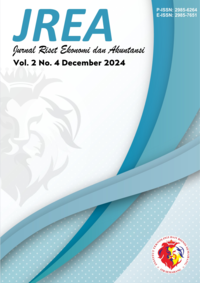Analisis Siklus Anggaran Pendapatan dan Belanja Daerah (APBD) di Kecamatan Krian Sidoarjo
DOI:
https://doi.org/10.54066/jrea-itb.v2i4.2538Keywords:
APBD, Expenditure Budget, Regional Revenue, Budget CycleAbstract
This study analyzes the Budget Cycle of Regional Revenue and Expenditure Budget (APBD) in Krian District, Sidoarjo, encompassing four main stages: planning, implementation, administration, and accountability. In the planning process, each work unit submits activities and budget needs that are verified before finalization by the Finance Subdivision Head. Challenges arise from discrepancies between planned and actual implementations in the field, necessitating quarterly evaluations. The implementation stage faces adjustments in expenditure priorities due to budget constraints from the central government. Administration involves the management of Financial Accountability Reports (SPJ) and the use of the SIPD and SIKDA systems, despite technical challenges. Financial reports are prepared periodically and verified by the Inspectorate and the Audit Board (BPK). Major challenges include asset recording that is often inconsistent with existing items, as well as difficulties in meeting routine budget needs. Although routine needs are typically met up to 90%, certain items such as travel expenses and salaries cannot be increased if the budget is insufficient. The effectiveness of the APBD cycle in Krian District is reflected in structured planning and flexible implementation, with periodic evaluations that uphold accountability and transparency. This study shows that with a good administration and reporting system, Krian District can overcome challenges and maintain focus on achieving the established development goals.
Downloads
References
Aulia, Y., Hasibuan, D. S. B., Waruwu, H., Gulo, P. D., & Nurhaliza, S. (2024). Transparansi dan Akuntabilitas Pengelolaan Keuangan Daerah di Kabupaten Deli Serdang. Journal of Student Research, 2(2), 79–86. https://doi.org/10.55606/jsr.v2i2.2809
Ishak, H. A. F. (2005). Reformasi Paradigma dan Transparansi Keuangan Pemerintah Daerah. Jurnal Borneo Administrator, 1(2), 9–15. Retrieved from https://samarinda.lan.go.id/jba/index.php/jba/article/view/8/8
Lesang, I., & Lule, A. (2024). Aspek Hukum dan Filosofi Penetapan APBD Menggunakan Instrumen Peraturan Bupati di Pulau Morotai. Musamus Journal of Public Administration, 6(2), 642–651. Retrieved from https://ejournal.unmus.ac.id/index.php/fisip/article/download/5628/3249/
Miles, M. B., & Huberman, A. M. (1994). Qualitative Data Analysis: An Expanded Sourcebook. SAGE Publications.
Ramdhany, M. R. (2018). Analisis Komoditas Unggulan Sub Sektor Pertanian Terpilih berdasarkan Volume Produksi di Kabupaten Malang. Jurnal Ilmiah Mahasiswa FEB Universitas Brawijaya, 6(1), 1–23. Retrieved from https://jimfeb.ub.ac.id/index.php/jimfeb/article/view/4608
Ridwan, R., & Nawir, I. S. (2021). Buku Ekonomi Publik. Yogyakarta: Pustaka Pelajar.
Downloads
Published
How to Cite
Issue
Section
License
Copyright (c) 2024 Jurnal Riset Ekonomi dan Akuntansi

This work is licensed under a Creative Commons Attribution-ShareAlike 4.0 International License.







